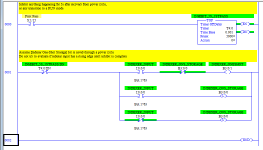Bobobodopalus
Member
Hi all,
i have a very slow indexing machine where we are looking to make everything as bulletproof as possible, money is not much of a factor here. this will be a compactlogix machine so using studio5000
i currently use what i assume is a very normal FIFO shift register arrangement which is triggered by a sensor at the end of the index.
when being asked about potential issues with it the only thing i could think of really is a very unlucky power outage where the motor would come to a stop on the sensor when it is no longer powered, i think they will probably have to live with this but did want to see if any other options exist.
is it possible to tie a bit to a position on an absolute encoder?
i am imagining that i can essentially create my starwheel in the plc putting a can into pocket 1 and then having this can bit tied to that pocket.
sadly i dont know how to achieve this, especially on a compactlogix, would love to know some other methods of shift registers anyone has used.
i have a very slow indexing machine where we are looking to make everything as bulletproof as possible, money is not much of a factor here. this will be a compactlogix machine so using studio5000
i currently use what i assume is a very normal FIFO shift register arrangement which is triggered by a sensor at the end of the index.
when being asked about potential issues with it the only thing i could think of really is a very unlucky power outage where the motor would come to a stop on the sensor when it is no longer powered, i think they will probably have to live with this but did want to see if any other options exist.
is it possible to tie a bit to a position on an absolute encoder?
i am imagining that i can essentially create my starwheel in the plc putting a can into pocket 1 and then having this can bit tied to that pocket.
sadly i dont know how to achieve this, especially on a compactlogix, would love to know some other methods of shift registers anyone has used.





